Gateway FPD2485W: 24" LCD Beauty or Beast?
by Jarred Walton on February 22, 2007 10:00 AM EST- Posted in
- Displays
Features - OSD
One of the more interesting aspects of this LCD is its On-Screen Display (OSD). Depending on how you intend to use the LCD, you may find yourself accessing the OSD infrequently or on a regular basis. If you use multiple inputs, you will use the OSD to select among the various connected devices. We definitely get the impression that Gateway was trying to make a "cool" OSD. Rather than having actual buttons, the right black border hides touch sensitive areas that light up when you press the menu option.
The initial press of the menu button brings up several quick access options to get you to the most commonly used areas. At the top is a "scrollable" area where you can select among several different color themes: movie, web, picture, game, warm, cool, and user. These options basically adjust the brightness, contrast, and color levels to preset values, with the exception of "user" which is for user-defined adjustments. The next four options provide quick access to input selection, picture in picture settings, and video adjustments. The bottom option takes you to the main menu, which is necessary in order to reach a few other areas.
Choosing among the six available inputs is pretty simple. After exiting the Input Select option, you choose the appropriate input and you're done. The currently active input is not listed, which is why there are only five inputs shown - we used the DVI input for most of our testing. It's a bit odd that they don't simply put the sixth input in place of the Cancel option, however, so that all of the menu items would always be in the same position.
Outside of the initial menu and input selector, the way the On-Screen Display functions changes - somewhat counter-intuitively, we might add. The remaining menus move the various options into a gray area on the left side of the OSD, and the top "scroll" buttons are now used to move up and down among the options. These buttons aren't particularly sensitive, so sometimes you will tap a button and get no result while other times you will push it once and the selection will jump twice. Above you can see the images of the Picture, PIP, and Advanced menus; the various submenus are self-explanatory and we didn't bother capturing screenshots taking pictures.
The final two OSD menus contain items related to adjustment of signal properties. If you are using a digital connection, several of the items are grayed out - Sharpness, Noise Reduction, Film Mode, and Video Enhance all deal with improving the quality of analog signals. Video Scaling allows you to customize how non-native resolutions are handled, including the option of displaying the content at a one-to-one ratio (unscaled). The Panoramic function is a nonlinear stretch that is only available with analog connections.
The OSD certainly provides all of the options we like to see, but navigating through the various menus is not quite as straightforward as we would like. This is due in part to the less sensitive "scroll" buttons at the top of the menu - or at least they didn't seem to be quite as responsive as the other menu buttons. If you find yourself frequently accessing the OSD menus, it can be a little irritating at times, and it seems like things could have been made easier by turning the "scroll" area into a couple more buttons and eliminating the need to move up and down among the various options. Still, the OSD does provide a good set of adjustments, and while it could have been streamlined it works well enough to get the job done.
One of the more interesting aspects of this LCD is its On-Screen Display (OSD). Depending on how you intend to use the LCD, you may find yourself accessing the OSD infrequently or on a regular basis. If you use multiple inputs, you will use the OSD to select among the various connected devices. We definitely get the impression that Gateway was trying to make a "cool" OSD. Rather than having actual buttons, the right black border hides touch sensitive areas that light up when you press the menu option.
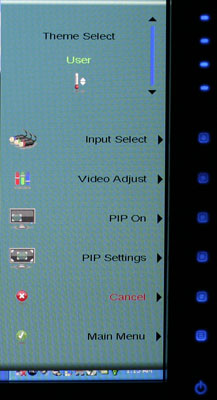 |
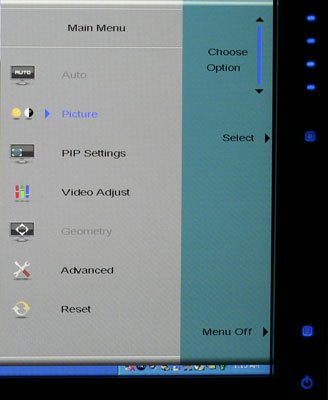 |
| Click to enlarge | |
The initial press of the menu button brings up several quick access options to get you to the most commonly used areas. At the top is a "scrollable" area where you can select among several different color themes: movie, web, picture, game, warm, cool, and user. These options basically adjust the brightness, contrast, and color levels to preset values, with the exception of "user" which is for user-defined adjustments. The next four options provide quick access to input selection, picture in picture settings, and video adjustments. The bottom option takes you to the main menu, which is necessary in order to reach a few other areas.
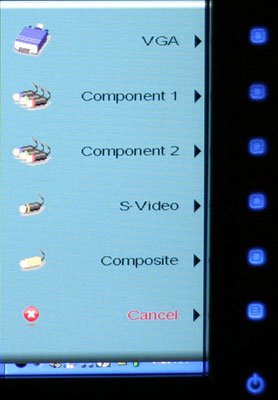 |
| Click to enlarge |
Choosing among the six available inputs is pretty simple. After exiting the Input Select option, you choose the appropriate input and you're done. The currently active input is not listed, which is why there are only five inputs shown - we used the DVI input for most of our testing. It's a bit odd that they don't simply put the sixth input in place of the Cancel option, however, so that all of the menu items would always be in the same position.
 |
 |
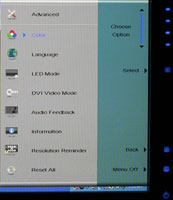 |
| Click to enlarge | ||
Outside of the initial menu and input selector, the way the On-Screen Display functions changes - somewhat counter-intuitively, we might add. The remaining menus move the various options into a gray area on the left side of the OSD, and the top "scroll" buttons are now used to move up and down among the options. These buttons aren't particularly sensitive, so sometimes you will tap a button and get no result while other times you will push it once and the selection will jump twice. Above you can see the images of the Picture, PIP, and Advanced menus; the various submenus are self-explanatory and we didn't bother capturing screenshots taking pictures.
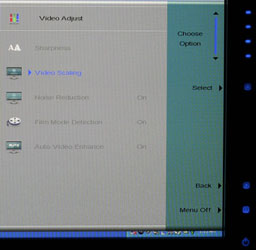 |
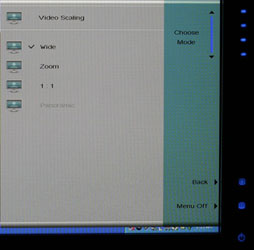 |
| Click to enlarge | |
The final two OSD menus contain items related to adjustment of signal properties. If you are using a digital connection, several of the items are grayed out - Sharpness, Noise Reduction, Film Mode, and Video Enhance all deal with improving the quality of analog signals. Video Scaling allows you to customize how non-native resolutions are handled, including the option of displaying the content at a one-to-one ratio (unscaled). The Panoramic function is a nonlinear stretch that is only available with analog connections.
The OSD certainly provides all of the options we like to see, but navigating through the various menus is not quite as straightforward as we would like. This is due in part to the less sensitive "scroll" buttons at the top of the menu - or at least they didn't seem to be quite as responsive as the other menu buttons. If you find yourself frequently accessing the OSD menus, it can be a little irritating at times, and it seems like things could have been made easier by turning the "scroll" area into a couple more buttons and eliminating the need to move up and down among the various options. Still, the OSD does provide a good set of adjustments, and while it could have been streamlined it works well enough to get the job done.










77 Comments
View All Comments
anandtech02148 - Thursday, February 22, 2007 - link
I find the Westinghouse 37 lcdtv eye candies with all the pluggins you could want, for pc, consoles and whatever hi-def format.and it has native resolution as this Gateway 24.
Dell is losing it touches lately, Westinghouse got a niche here they should runaway with it.
JarredWalton - Thursday, February 22, 2007 - link
I'll see if I can get one for review - I'd certainly like to check out some of the LCD-TVs that can function as computer displays. Of course, pixel pitch is going to be a lot larger on a 37" 1080p display, and while that may be fine for HDTV and gaming purposes, it probably isn't the best for close up computer work.Welshtrog - Thursday, February 22, 2007 - link
I am looking at these displays with interest, however there is nothing in this review that will change my mind regarding retaining my 19" Flat screen CRT just yet, It has good colour accuracy after being set up and no stuck pixelsJarredWalton - Thursday, February 22, 2007 - link
I've got two decent 19" CRTs still (NEC FE991 and Samsung 997DF), and honestly I can't stand using them after I switched to a 24" LCD 18 months ago. I still get irritated by image tear caused by the 60Hz refresh rate, but in all other areas I'm a lot happier with larger LCDs over CRTs. Part of that is simply the expanded screen size, but the reduced footprint is nice as well. I bailed on CRTs a few years ago and haven't really missed them, although I can certainly understand the hesitation. The $600+ prices doesn't help either. :)Justin Case - Thursday, February 22, 2007 - link
The review doesn't address this. I know it says "16 million colors", but all manufacturers say that, and 90% of them use 6-bit panels with automatic dithering. The fact that this is an active matrix TFT, coupled with the very low resposne time suggests that this is a 6-bit panel, like the majority.This means more banding and dithered midtones. Which is probably fine for "office" use, but it makes the LCD unusable for photo work (actually, any LCD short of an Eizo CG is pretty much useless for photo work, IMO, and even those just barely manage to match a high-end CRT), and can make games and movies look pretty bad, too.
To test this, just display a smooth gradient (at the monitor's native resolution) and either look at it very closely or take a photograph of a very small area (about 10 pixels wide), and then increase its contrast until the darkest color is black and the brightest color is white. If you see dithering or banding at the pixel level in the intermediate shades, it's a 6-bit panel.
Aquila76 - Thursday, February 22, 2007 - link
It is an 8 bit S-PVA panel, like the Dell and Samsung 244t. It does 'real' 16.7 million colors, but as I stated previously (and as Jarred can attest) it is nowhere near accurate.Justin Case - Thursday, February 22, 2007 - link
I'd still like to see a "real" test of the screen (by taking a high-speed photo of a small area). Some panels out there do intermeidate colors by flipping between two shades. The panel _accepts_ 8-bit values, but the LCs don't actually have 256 stable transparency levels.Not that I'm very interested in this particular model, but I think it would be useful if review sites actually did that, rather than trusting what the manufacturers tell them.
Even in high-end professional equipment there's a lot of deception. Consumer stuff is even worse (ex., until about a year ago there were almost no real 1920x1080 HDTV sets out there; apart from Sharp, they were all 1366x768 and below, but they all claimed to "support 1920x1080", because they could take it as an input signal).
strikeback03 - Thursday, February 22, 2007 - link
meh, the color calibration results aren't great, considering on my laptop I have an average dE of around .6 and only 3 values over 1 (out of the 42 tested by my Eye-One Display 2). I'll probably still pick one up though, as it's the only locally available 24" display.Other reviews I read online spoke of crushed blacks which calibration did not correct when viewing movies. Any comments on this?
Gary Key - Thursday, February 22, 2007 - link
Jarred is currently reviewing the requests/questions and will have responses later today.
xtknight - Friday, February 23, 2007 - link
When you calibrate using a colorimeter and accompanying software, it only loads the LUT (lookup table) on to the desktop. When you watch a movie, most of the time you're using overlay, which to my knowledge does not allow the fine tuning needed for a lookup table. With VMR you could potentially view videos calibrated, although the last time I tried this I had some odd 16-240 level compression problem.I've been meaning to investigate the overlay "LUT" (or to even find if it exists in the first place). I've seen a function in NVIDIA's control panel API that allows the loading of a LUT onto the overlay surface so I'll see what's up with that.